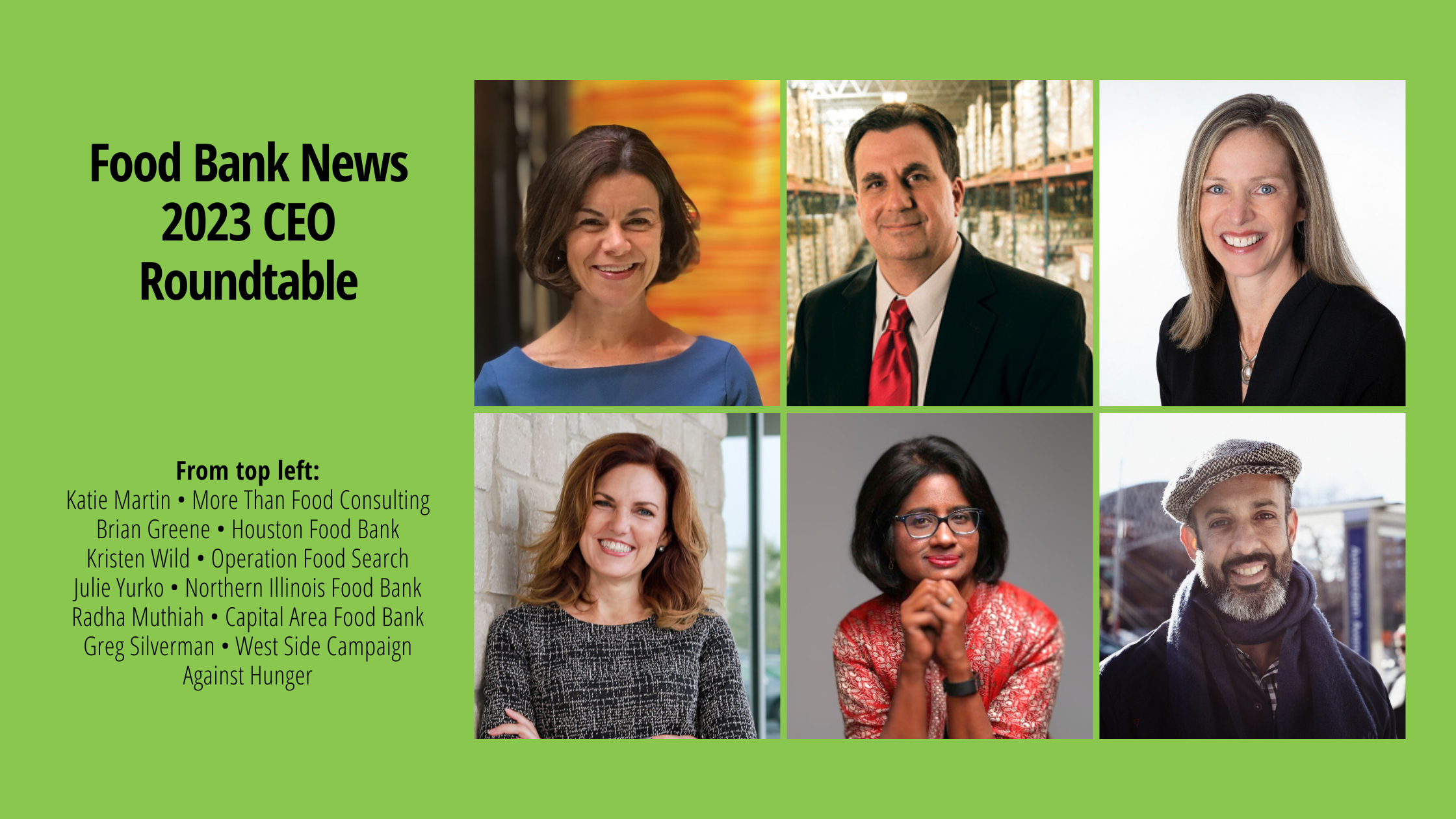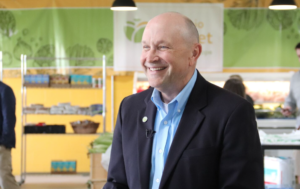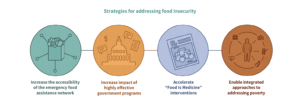In contemplating what food banking might look like in five or so years, the CEOs of our Food Bank CEO Roundtable imagined the ways in which food banks might act more like high-tech, consumer-oriented companies – and the ways in which they might not.
Food banks and pantries started out more than 50 years ago by supplying people with pre-packed bags of food, but now they are much more likely to take into account the specific needs and desires of their clients by giving them a choice of food. In our hour-long conversation, the word “choice” was uttered nearly 30 times.
The concept of choice is now expanding well beyond just the type of food people are offered. As with retailers that let consumers shop in the store or go online, food banks are also applying the concept of choice to access. “I love that you get to choose the food, but you also get to choose the way in which you receive the food,” said Julie Yurko, President and CEO of Northern Illinois Food Bank (more on Northern Illinois’ approach here). “The neighbor can say, ‘This week, I need it delivered. Next week, I want to go shop in the store.’”
Choosing how to access food is becoming even more important than choosing the type of food, in the view of Greg Silverman, CEO and Executive Director of West Side Campaign Against Hunger. A current focus at WSCAH is a pilot with an online grocer in which it will offer food (likely with some restrictions in choice), along with access to SNAP benefits and unlimited home delivery. “We know where the market’s going in the for-profit world when it comes to grocery shopping,” Silverman said. Surveys of WSCAH’s 75,000 customers show that “they would take a choice of where, when and how over kale versus collard greens,” he said.
Radha Muthiah, President and CEO of Capital Area Food Bank, sees partnerships with for-profit companies as a possibility, including adapting existing market-based platforms like Instacart or Amazon Fresh to be “more friendly” to food-insecure people, perhaps by removing fees or creating landing pages to facilitate their engagement. In such a scenario, which is possibly ten years off, less food would actually go through food bank warehouses, she said.
For-profit companies still need to be convinced of the value of working with non-profits, the CEOs noted. Food banks and pantries have connections to millions of food-insecure people, offering the possibility of helping for-profit companies add to their market share through lower customer acquisition costs. It’s a matter of understanding how many new customers are needed to actually lower or eliminate fees, Muthiah said. “We’re probably all having these conversations on how we can achieve that access, affordability and choice using an existing platform,” she added.
Like retailers, food banks are also getting into the cross-promotion business. Because food insecurity is so tied to other social issues, such as housing, low wages and health, connecting clients to other community-based social services is important. “Addressing the underlying root causes creates the need for other resources and partnerships,” noted Katie S. Martin, PhD, CEO of More Than Food Consulting.
Another way in which the hunger relief community is looking a bit more like the for-profit world is a growing propensity to charge (at least modestly) for food (more on this here). St. Louis-based Operation Food Search, for example, two years ago launched a mobile grocery store that travels to food deserts, offering a wide selection of healthy food at lower-than-normal prices. “This is the first time that we have a model where we’re charging people for food,” said Kristen Wild, President and CEO of Operation Food Search.
Clients of the service typically have some income, but few grocery-store options. It’s a different target population than those who are severely income-limited and more likely to gravitate toward free food. “This is an opportunity for people to shop,” Wild said. “They’re paying less than what they would at the grocery and they’re getting great, great selection. So I could see things moving more in this direction.”
When it comes to Food as Medicine, food banks may be less likely to act like consumer-oriented companies, ceding certain operations to the for-profits. The delivery of healthy food boxes, for example, “doesn’t really play to our strengths as much as we think it does,” said Brian Greene, President and CEO of Houston Food Bank. “That plays to Amazon’s strengths.” Similarly, medically tailored meals are an expensive, niche service that food banks will likely not end up doing at scale, he said.
For-profit food box companies that have figured out how to get reimbursed by public and private insurers to deliver food have marketing muscle that goes well beyond the capacity of the typical food bank. “What they invest in selling themselves is way more than we would ever even think of doing,” Greene said. “We’re running a charitable business, and maybe we’ll work on [Food as Medicine] a little bit on the side. They’re seriously investing in how they make this a big profitable enterprise.”
All of that does not mean that food banks cannot compete in the Food as Medicine space. To some extent, the for-profit companies are “playing off the myth” that food banks provide sub-quality food, rather than realizing that they are increasingly focused on providing healthy, culturally familiar foods, Muthiah said. “I also think some of them think it’s easy to get into this business and they may do well for a few years, and then they may disappear.”
The independent nature of all of the food banks around the country presents a challenge in competing with for-profit food box companies, noted Yurko. But it can be done. “It’s just going to take us aligning and getting the funding to get it done.” – Chris Costanzo
Like what you’re reading?
Support Food Bank News
This article was made possible by the readers who support Food Bank News, a national, editorially independent, nonprofit media organization. Food Bank News is not funded by any government agencies, nor is it part of a larger association or corporation. Your support helps ensure our continued solutions-oriented coverage of best practices in hunger relief. Thank you!
Connect with Us:















